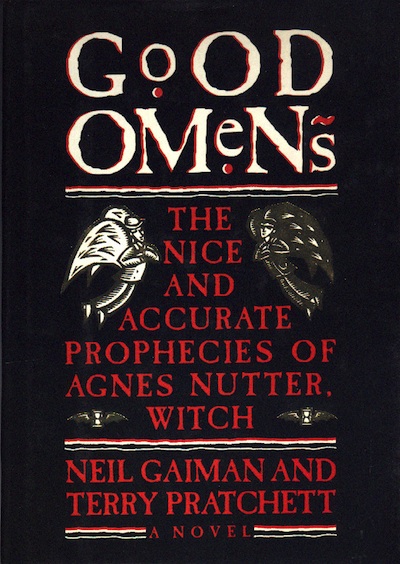There is some very interesting theological ground to cover where Good Omens is concerned, especially considering that the whole book is basically giving its own spin on the Book of Revelation. Truthfully, there is so much ground to cover that it didn’t fit in the Reference Guide. So without further ado, here are the items in the book that dealt with religions, mythologies, and rituals of all sorts….
Aziraphale:
- Aziraphale’s Name—has always been the cause of some dispute over the years in regard to pronunciation. (For the record, Pratchett has said that it was meant to be pronounced “Azz-ear-raf-AE-el,” but that he and Gaiman ended up pronouncing it “Azz-ear-raf-ail” over the years, so that’s what we’ve got now.) Terry Pratchett has said that while the name was invented, it fits into angelic “canon” as it were, which is true in more than one religion. Various faiths support angels with the names of Raphael, Mikhail, Gabriel, Azrael, and so forth, which phonetically falls in with Aziraphale.
- Principality—“Aziraphale was a Prinicipality, but people made jokes about that these days.” In Christianity, Principalities are said to be in the Third Angelic Sphere, below Seraphim, Cherubim, Ophanim, Dominions, Virtues, and Powers. They are meant to bring blessings to the material world and oversee groups of people. They are also said to educate and guard the Earth and inspire humanity. Considering how far humanity has come by the 20th century, it is not all that surprising that other angels make fun of Aziraphale’s job these days.
Bible(s):
-
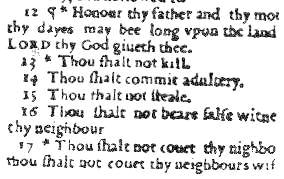 Infamous Bibles—Most of the bibles listed in Aziraphale’s collection do, in fact, exist, with the exception of the Charing Cross Bible and the Buggre Alle This Bible. Ones that are not mentioned include the Rebecca’s Camels Bible and the Ears to Ear Bible.
Infamous Bibles—Most of the bibles listed in Aziraphale’s collection do, in fact, exist, with the exception of the Charing Cross Bible and the Buggre Alle This Bible. Ones that are not mentioned include the Rebecca’s Camels Bible and the Ears to Ear Bible.
Christian Figures:
- Beelzebub—is Hell’s representative at Armageddon. Crowley gets cut off when he tries to introduce him as “Lord of the Flies,” likely because the current version of Beelzebub is a combination of two Biblical figures: Baalzebûb, Ekron’s god, who was called lord of the flies because he kept flies away from sacrifices, and Beelzeboul, an evil spirit who was known for instigating wars, getting demons worshipped, and bringing about murder and jealousy and the like.
-
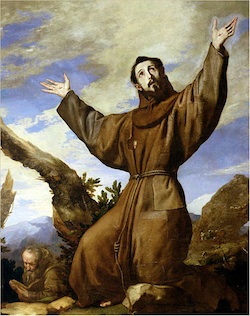 Brother Francis—Aziraphale’s agent sent to mentor Warlock is meant to be Saint Francis of Assisi. He is the patron saint of animals and the environment, which is why Warlock makes mention of his teaching respect for all living things, and why he is often covered in birds.
Brother Francis—Aziraphale’s agent sent to mentor Warlock is meant to be Saint Francis of Assisi. He is the patron saint of animals and the environment, which is why Warlock makes mention of his teaching respect for all living things, and why he is often covered in birds. - Gabriel—The archangel sounds like something of a bureaucrat in Heaven from the way Aziraphale seems keen to steer clear of his notice.
- Metatron—is Heaven’s representative at Armageddon, being the Voice of God (not the actual voice—he’s described as a “presidential spokesperson”). According to Rabbinic tradition, Metatron is the celestial scribe. It is said that he was Enoch, an ancestor of Noah, who became an angel.
Genesis:
- 4004 BC, October 23 at 9AM—is listed as an incorrect date for the beginning of the world. But even this date is cited falsely in Good Omens; the Archbishop who came up with it was named James Ussher (not Usher), and the work he wrote was titled Annales Veteris Testamenti (rather than Annales Veteris Et Novi Testamenti). Apparently, Ussher is frequently misquoted for the time of Earth’s creation—he suggested that it was at noon, not 9AM or PM. In other works, he gives an entirely different date of January 1, 4003 BC, at 6PM.
-
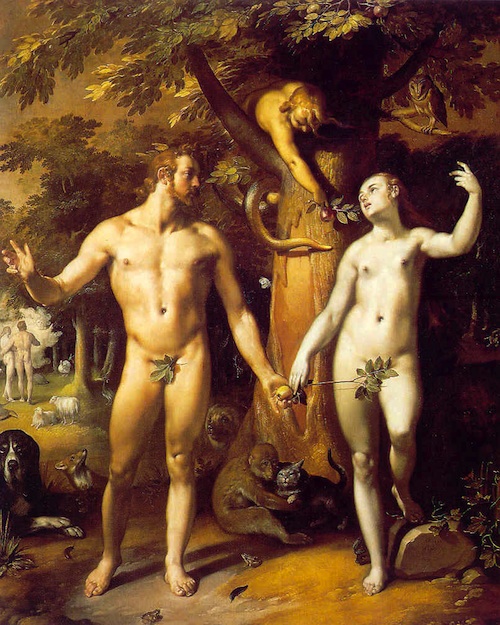 Apples—Adam has a preoccupation with stealing apples from a neighbor’s tree. While this is the sort of behavior you would expect from a boy like him, it is also a call back to Adam eating the apple from the Tree of Knowledge in Eden.
Apples—Adam has a preoccupation with stealing apples from a neighbor’s tree. While this is the sort of behavior you would expect from a boy like him, it is also a call back to Adam eating the apple from the Tree of Knowledge in Eden. - Crawley—Crowley’s snake name from when he played the role of the Serpent in Eden. He retains snakeskin boots (that may not be boots) and snake eyes, which he hides behind sunglasses. Though some choose to view the Serpent of Eden as Satan, it is not until later points in the Bible that Satan is represented outright as a snake.
- Dog—Adam’s naming of his hellhound is meant to be reminiscent of the original Adam’s naming of all the animals on Earth. (Genesis 2:19)
- Flaming Sword—Aziraphale has a flaming sword that he gives to Adam and Eve after they are banished from Eden because they look cold. According to Genesis 3:24, the flaming sword was placed at the gates of Paradise after Adam and Eve’s expulsion as a way of preventing humans from returning. Clearly, this was not the case. Also, the Bible states that a Cherub is the one in possession of the sword at the Eastern Gate, not a Principality like Aziraphale.
- Wormwood—While this name suggested for Adam could have been in reference to The Screwtape Letters by C.S. Lewis, it could also be reference to the plant that rose up behind the serpent (Crowley, then Crawley) when it was cast out of Eden.
Mythology:
- Baron Saturday—Sergeant Shadwell says that Mister Rajit probably sacrifices chickens to him, meaning Baron Samedi, of course.

- Hellhounds—Dog is meant to be a hellhound, sent to be pet of the Antichrist. The appearance of hellhounds dates far back, however, and the Greek hound Cerberus (Kerberos) is perhaps the closest mythology comes to matching Dog and Adam’s relationship, as Cerberus was the dog of Hades, king of the Underworld.
- Nanny Astoreth—Crowley’s agent sent to be Warlock’s nanny is named for Ashtoreth, the Hebrew-ized name given to Astarte, otherwise known as Ishtar, the Mesopotamian goddess of sexuality, fertility, and war. In the Hebrew Bible, Ashtoreth is referred to as the Phoenician goddess tied to the power of nature. She sings Warlock a parody of the “Grand Old Duke of York” nursery rhyme.
- “Women wi’ too many arms”—Shadwell makes mention of them being witches, and is likely referring to the Hindu goddess Kali (and various other Hindu figures) without realizing it.
 Religious Rules and Sundry:
Religious Rules and Sundry:
- Book, Bell and Candle—Shadwell uses (nearly) these items to exorcise Azirphale. The book, bell, and candle are used when serious offenders are excommunicated from the Catholic Church.
- The Cabbala—Aziraphale has bits from the Cabbala on the floor surrounding a chalk circle that he uses to communicate with Heaven. Cabbalism is a system of thought developed by Rabbis in the Middle Ages, not a denomination.
- Compline—A religious time of day that Crowley confuses with Complan, a slimming aid. Compline is the final church service of the day, often set at 6PM.
- Seven Candles—Also used in Aziraphale’s attempt to call to heaven are seven candles. Seven is a very important number in Christianity, the number of perfection. God rested on the Seventh Day after He created the world. In addition, seven features very heavily in the Apocalypse; there are seven seals, seven churches, and seven bowls.
Revelations:
- Adam Young—Adam’s role as the Antichrist is given a very free interpretation in Good Omens, largely due to the fact that the Antichrist as a figure is relatively vague throughout the New Testament. The times that the term is used in the Bible is often for the purpose of marking a group of people rather than an individual, and some believed that the Antichrist would be Beast out of the Earth mentioned in Revelations. In addition, whatever the Antichrist’s role was intended to be during Armageddon was bound up in a fight against Christ and the army he led. It is possible that the reason we never see any of this is because Adam stops the whole circus before it ever gets that far. What is further fascinating is that it all lies within Adam’s power to stop in the first place, suggesting that either the prophecy of Revelations has to be completed in its entirety to move forward, or that the Antichrist has far more power in the process than the Book of Revelation suggests.
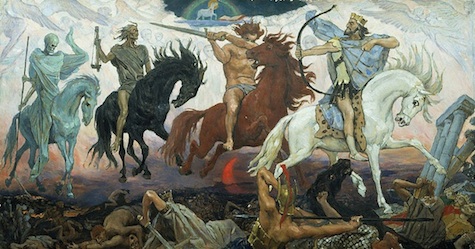
- Armageddon’s Location: The Four Horsepersons seem confused at first about where the Apocalypse is supposed to take place/begin. Some believe that the word that Armageddon comes from may have translated to “the mountain of Megiddo,” Mount Carmel, where the Carmelite religious order was founded, and possibly where Elijah proved that the one God was the deity of the Kingdom of Israel. This is mentioned again when Hell’s agents take Warlock to “the fields of Megiddo” and realize that he cannot be the Antichrist because he doesn’t know what to do there.
- Horsepersons—are the Four Horsemen of the Apocalypse in the Bible. They also have color-coded rides in Revelations: War is on a red horse, Famine on a black horse, and so on, reflecting the names the Horsepersons take in the story as well. Interestingly, however, the figure riding the white horse was typically thought to be “Conquest.” The change of this Horseman to Pestilence is recent and more common in pop culture.
- Kraken—Instead of the Antichrist being the Beast out of the Earth, Good Omens puts the Kraken to good use, there to get vengeance for all the sushi dinners of the world.
- “One third of the seas turning to blood”—Aziraphale suggests that this doesn’t have to happen to Metatron, referring specifically to Chapter 16 out of Revelations, dealing with the Seven Bowls.
- Pollution—The Horseman Pestilence is changed to Pollution for the purposes of this story. The suggestion is not that Pestilence has been usurped, but rather that he has morphed into Pollution as the problems of man changed over the course of time.
And there are likely so many more, so pile them on!
Emmet Asher-Perrin had a bird as a child named “Birdie Birdie.” It was not her idea, but she supposes she understands Adam’s impetus there. You can bug her on Twitter and read more of her work here and elsewhere.










